If you’re looking for the best professional audio interfaces for studio-quality sound in 2025, I recommend models with high-resolution 24-bit/192kHz support, top-tier preamps, and excellent conversion tech like Focusrite Scarlett, Universal Audio Volt, or PreSonus Studio series. These interfaces boost clarity, dynamic range, and low latency for streaming, recording, or mixing. They’re also compatible with various DAWs and devices. Stay with me to explore each option and find the perfect fit for your studio needs.
Key Takeaways
- Highlight interfaces supporting 24-bit/192kHz resolution for optimal high-fidelity studio recordings.
- Emphasize models with premium preamps and high-quality analog-to-digital converters for superior sound clarity.
- Prioritize interfaces compatible with major DAWs and offering comprehensive software bundles for versatile production.
- Consider durability, portability, and multiple connectivity options like USB-C, Thunderbolt, and bus-powered design.
- Account for features like low latency, expandability, and additional I/O to meet diverse professional studio needs.
Focusrite Scarlett 2i2 4th Gen USB Audio Interface

If you’re looking for a versatile audio interface that combines professional-quality sound with user-friendly features, the Focusrite Scarlett 2i2 4th Gen is an excellent choice. It’s perfect for recording, streaming, and podcasting, whether you’re a beginner or pro. With a 120dB dynamic range and high-quality converters, it delivers studio-grade sound. The 4th Gen mic preamps provide clear, detailed vocals and instruments, while Air mode adds presence and harmonic richness. Auto Gain and Clip Safe features make setup easy, so you can focus on creativity without technical worries. Plus, it comes with essential software like Pro Tools Intro+ and Ableton Live Lite, making it a complete package.
Best For: musicians, streamers, podcasters, and home recording enthusiasts seeking professional-quality sound with user-friendly features.
Pros:
- High-fidelity 120dB dynamic range with premium converters for studio-quality audio
- User-friendly features like Auto Gain and Clip Safe simplify setup and recording
- Includes industry-standard software such as Pro Tools Intro+ and Ableton Live Lite for complete production
Cons:
- Limited I/O options with only two inputs, which may restrict more complex setups
- May be more expensive than entry-level interfaces for casual hobbyists
- Requires USB connection, which could limit mobility in some recording environments
Focusrite Scarlett Solo 3rd Gen USB Audio Interface

The Focusrite Scarlett Solo 3rd Gen USB Audio Interface stands out as an ideal choice for solo artists, podcasters, and home studio enthusiasts seeking professional-grade sound without complexity. It delivers high-quality recordings with bright, clear sound thanks to its premium mic pre-amps and switchable Air mode for extra clarity on acoustic instruments. The two high-headroom instrument inputs ensure clean, distortion-free recordings. Supporting up to 24-bit/192kHz, it preserves every sonic detail. Its user-friendly design includes Gain Halos for maximum levels and private headphone monitoring. With an extensive software bundle and a three-year warranty, the Scarlett Solo makes professional recording accessible and reliable.
Best For: solo artists, podcasters, and home studio enthusiasts seeking professional-quality sound with easy setup and reliable performance.
Pros:
- High-quality 24-bit/192kHz recording for detailed sound preservation
- User-friendly design with Gain Halos and private headphone monitoring
- Comes with a comprehensive software bundle including Pro Tools Intro+, Ableton Live Lite, and more
Cons:
- Limited to two inputs, which may not suit larger recording setups
- No built-in MIDI support or additional connectivity options
- Requires a USB port and compatible computer, which might limit portability in some situations
Focusrite Scarlett Solo 4th Gen USB Audio Interface
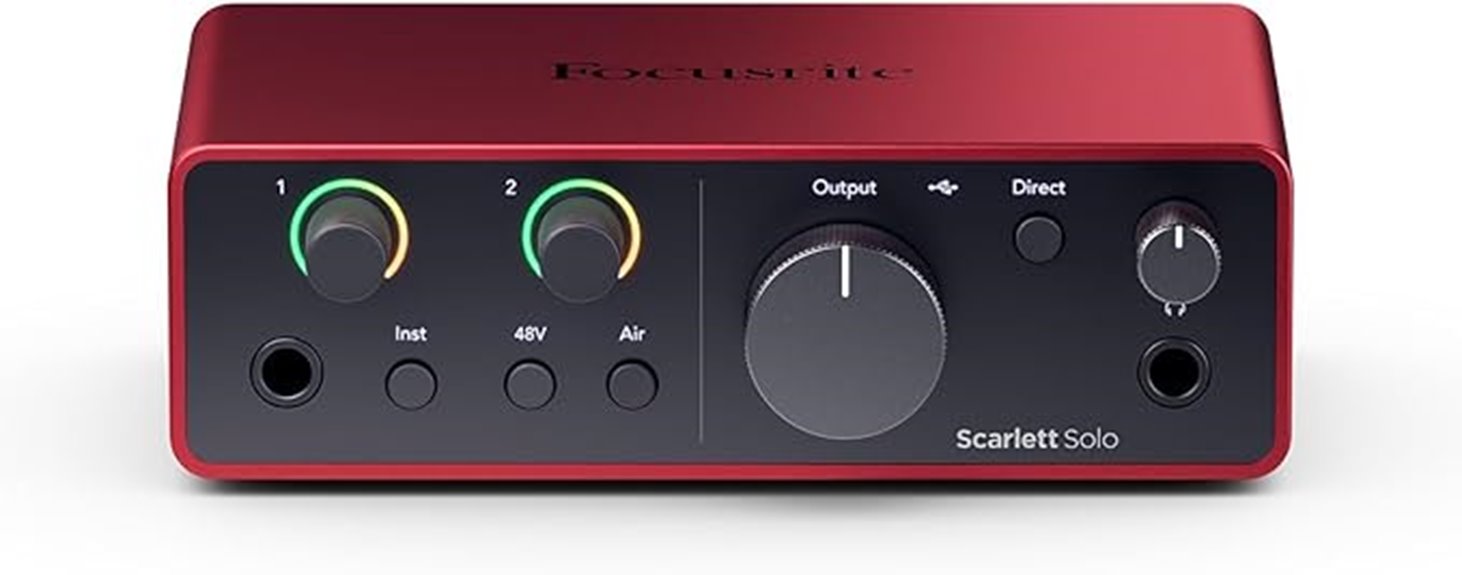
Designed for guitarists, vocalists, and producers seeking professional, studio-quality recordings, the Focusrite Scarlett Solo 4th Gen USB Audio Interface stands out with its impressive 120dB dynamic range and high-quality converters. It delivers pristine sound, capturing every nuance of your performance. The addition of Air mode enhances vocals and guitars by adding musical presence and harmonic richness, helping you find your signature tone. Plug in microphones and guitars effortlessly, making it suitable for various setups. With included software like Pro Tools Intro+ and Ableton Live Lite, plus six months of FL Studio, it offers everything needed for professional recording, mixing, and mastering.
Best For: guitarists, vocalists, and producers seeking professional, studio-quality recordings with easy connectivity and comprehensive software tools.
Pros:
- High 120dB dynamic range with top-tier converters for pristine sound quality
- Features Air mode to enrich vocals and guitars with harmonic presence
- Includes industry-standard recording software like Pro Tools Intro+, Ableton Live Lite, and FL Studio for versatile production
Cons:
- Limited I/O options compared to larger interfaces, which may restrict multi-instrument setups
- May require additional equipment or software updates for advanced features
- Compact design might be less suitable for complex recording studio environments
M-AUDIO M-Track Solo USB Audio Interface for Recording and Streaming

For anyone seeking a compact yet versatile audio interface, the M-AUDIO M-Track Solo stands out with its crystal-clear preamp technology and high-resolution 48 kHz recording quality. It’s perfect for recording, streaming, podcasting, or live performances. The combo XLR/Line input with phantom power handles microphones and line signals, while the dedicated Line/Instrument input suits guitars and instruments. Monitoring options include a headphone output and stereo RCA outputs, with a USB/Direct switch for zero-latency monitoring. Plus, the included MPC Beats software makes it easy to produce, edit, and mix your audio projects seamlessly.
Best For: musicians, streamers, podcasters, and home recording enthusiasts seeking a compact, high-quality audio interface with versatile input options and easy-to-use features.
Pros:
- Crystal Preamp technology ensures transparent and high-quality sound for all microphone types.
- High-resolution 48 kHz recording quality delivers professional-grade audio.
- Includes MPC Beats software for seamless production, editing, and mixing.
Cons:
- Limited to a single combo XLR/Line input, which may not suit multi-mic recording setups.
- No built-in effects or advanced processing features.
- May require additional accessories for complete studio integration (e.g., external preamps or interfaces).
M-AUDIO M-Track Duo USB Audio Interface for Recording and Streaming
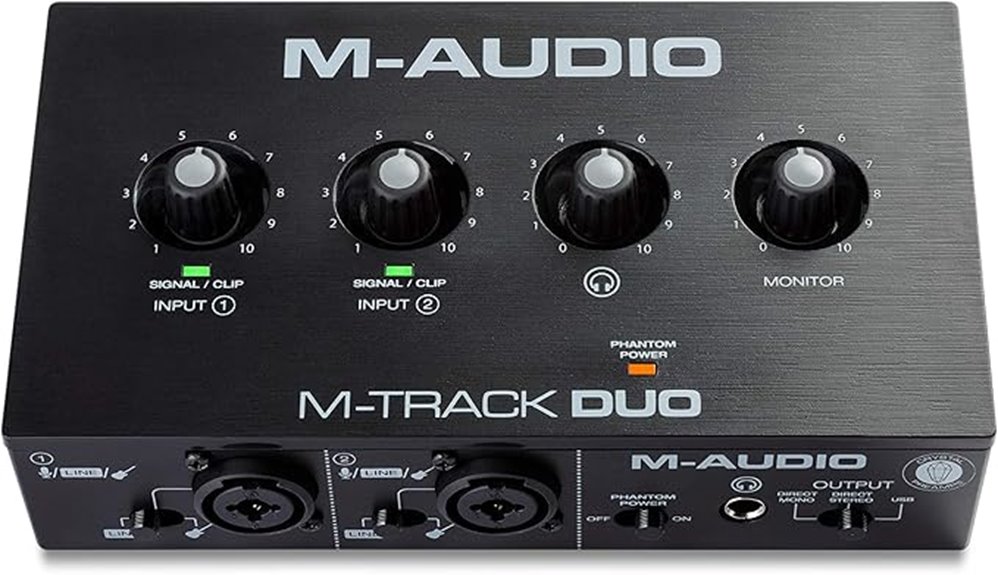
If you’re looking for a portable audio interface that delivers professional sound quality for recording and streaming, the M-AUDIO M-Track Duo is an excellent choice. It supports 48 kHz audio resolution, ensuring high-quality sound for your projects. Its dual combo XLR/Line/Instrument inputs with phantom power let you record vocals, guitar, or line signals effortlessly. The fuss-free zero-latency monitoring, with USB/Direct switch, makes tracking smooth and seamless. Plus, its transparent Crystal Preamps guarantee clear audio capture from any microphone. Including MPC Beats software, it’s a versatile tool for music creation, streaming, or podcasting, all in a compact, portable design that works with Mac and PC.
Best For: musicians, podcasters, and streamers seeking a portable, high-quality audio interface compatible with Mac and PC.
Pros:
- Supports 48 kHz high-resolution audio for professional sound quality
- Dual combo XLR/Line/Instrument inputs with phantom power for versatile recording options
- Zero-latency monitoring with USB/Direct switch for seamless tracking
Cons:
- Limited to two input channels, which may not suit larger recording setups
- No built-in effects or advanced processing features
- Requires external software for full production capabilities beyond basic recording
Universal Audio Volt 2 USB Recording Studio Audio Interface

The Universal Audio Volt 2 USB Recording Studio Audio Interface stands out with its classic UA 610 preamps and high-quality converters, making it an excellent choice for musicians and producers seeking professional-grade sound. It captures every detail with up to 24-bit/192 kHz fidelity, ensuring crystal-clear recordings. Paired with the award-winning LUNA DAW, it offers an authentic analog studio experience in a digital setup. You also get access to trusted UAD plug-ins and instruments, allowing you to craft professional sounds from home. Whether you’re a beginner or a pro, the Volt 2 helps elevate your recording and mixing skills with all-encompassing tips and tutorials.
Best For: musicians and producers seeking professional-quality recordings with classic analog sound in a user-friendly digital setup.
Pros:
- Offers authentic UA 610 preamp sound with professional-grade converters for high-fidelity recordings
- Compatible with the award-winning LUNA DAW and UAD plug-ins for versatile production options
- Suitable for users of all skill levels, providing tutorials and tips to enhance recording and mixing skills
Cons:
- May be more expensive than basic audio interfaces for casual hobbyists
- Requires a USB connection, which might limit mobility for some users
- Features are tailored toward high-quality production, possibly overkill for simple or quick recording needs
PreSonus Studio 24c 2×2 USB Audio Interface

The PreSonus Studio 24c 2×2 USB Audio Interface stands out as an ideal choice for musicians and producers seeking professional-grade sound in a compact setup. It supports up to 2 inputs and 2 outputs simultaneously, making it perfect for solo artists and small studios. The device features high-quality XMAX-L preamps and supports 24-bit resolution at various sampling rates up to 192 kHz, ensuring clear, detailed recordings. It offers balanced outputs for studio monitors, a high-power headphone jack, and intuitive controls like a mixer knob and level meters. Plus, with included Studio One 6 Artist software, you can start creating right away.
Best For: solo musicians, home producers, and small studio setups seeking high-quality audio recording and monitoring in a compact and affordable interface.
Pros:
- Supports up to 2 inputs and 2 outputs simultaneously for versatile recording options
- High-quality XMAX-L preamps with up to 192 kHz sampling rate ensure professional sound clarity
- Includes Studio One 6 Artist software for immediate music creation and recording
Cons:
- Limited to 2 inputs and 2 outputs, which may not suit larger recording setups
- No built-in MIDI I/O for integrating keyboards or controllers
- Lacks advanced features like multiple headphone outputs or DSP effects
Universal Audio Volt 1 USB Recording Studio Audio Interface

For musicians and producers seeking professional studio sound in a compact package, the Universal Audio Volt 1 USB Recording Studio Audio Interface stands out with its authentic analog preamps and high-resolution converters. It delivers the rich warmth of classic UA 610 preamps and captures every detail at up to 24-bit/192 kHz quality. Compatible with the award-winning LUNA DAW, it offers a seamless recording and mixing experience. Plus, access to the same trusted UAD plug-ins and instruments used by top industry pros elevates your sound. With helpful tips and tutorials included, it’s perfect for both beginners and seasoned producers aiming for professional results at home.
Best For: musicians and producers seeking professional studio-quality recordings and mixing capabilities in a compact, user-friendly interface suitable for both beginners and experienced users.
Pros:
- Authentic UA 610 preamps and professional-grade converters for high-quality sound
- Compatible with LUNA DAW and access to trusted UAD plug-ins and instruments
- Includes educational resources like tips and tutorials to enhance skills
Cons:
- Limited inputs and outputs may not suit large multi-instrument setups
- Higher cost compared to basic USB audio interfaces with fewer features
- Requires additional software and plugins for full professional use
Mackie Audio Interface, Onyx Artist 1X2 USB Audio Interface

If you’re looking for a portable audio interface that delivers professional sound quality, the Mackie Onyx Artist 1X2 stands out with its high-resolution 24-bit/192kHz recording capability. It features a boutique-quality Onyx mic preamp that offers superior fidelity and dynamic range, along with 48V phantom power for studio condenser microphones. The interface includes a ¼” TRS input with a Hi-Z switch, perfect for guitars and instruments, and a USB 2.0 connection for fast, low-latency transfer. Its bus-powered, rugged design makes it ideal for mobile recording, offering zero-latency monitoring, dedicated outputs, and a powerful headphone jack.
Best For: musicians and home studio enthusiasts seeking a portable, high-quality audio interface with professional-grade preamps and versatile inputs.
Pros:
- High-resolution 24-bit/192kHz recording for clear, professional sound quality
- Boutique-quality Onyx mic preamp with superior fidelity and dynamic range
- Rugged, bus-powered design ideal for mobile recording and durability
Cons:
- Limited to 2 input/output channels, which may not suit larger recording setups
- No built-in DSP or advanced control features for mixing and processing
- Requires USB connection, which may be less flexible for some studio setups
M-AUDIO AIR 192|14 USB-C Audio Interface for Studio Recording

With its 24-bit/192kHz resolution and premium components, the M-AUDIO AIR 192|14 USB-C Audio Interface delivers studio-grade sound quality perfect for musicians and producers who demand crystal-clear recordings. Its transparent crystal preamps and ultra-pristine AD converters guarantee accurate, detailed sound reproduction. The versatile connectivity includes USB-C and USB options, along with multiple inputs—4 combo, 2 instrument, and line inputs—plus various outputs for flexible monitoring. Low latency performance with only 2.59ms round-trip delay makes real-time tracking seamless. Built with a rugged metal chassis and intuitive controls, it’s a reliable, professional tool for high-quality studio recordings.
Best For: musicians, producers, and audio engineers seeking professional-grade, versatile studio recording capabilities with minimal latency.
Pros:
- Exceptional 24-bit/192kHz audio resolution ensures high-fidelity recordings and monitoring.
- Extensive connectivity options including multiple inputs, outputs, and MIDI ports for versatile setup.
- Durable metal chassis combined with intuitive controls makes it ideal for studio use and portable setups.
Cons:
- May be more expensive than entry-level audio interfaces for casual users.
- Requires compatible USB-C or USB connections, which might necessitate adapters for some devices.
- Limited onboard processing features; relies on external software for advanced effects and mixing.
Arturia MiniFuse 2 USB Audio & MIDI Interface with Software

The Arturia MiniFuse 2 USB Audio & MIDI Interface stands out for its combination of durability and versatility, making it an excellent choice for both beginners and seasoned musicians. Built to last, it’s tested over 200 times for reliability and backed by a 5-year warranty. Its compact, portable design makes recording on the go easy, whether in a studio or outdoors. It delivers professional sound quality with multiple inputs, MIDI connectivity, and loopback features. Plus, it includes user-friendly software like Ableton Live Lite and Auto-Tune Unlimited, supporting diverse creative workflows and simplifying music production for all levels.
Best For: musicians, vocalists, content creators, and producers seeking a durable, portable, and high-quality audio and MIDI interface suitable for studio, live, or on-the-go recording.
Pros:
- Robust 5-year warranty and over 200 reliability tests ensure durability and long-term performance
- Compact, plug-and-play design ideal for portable use in various environments
- Includes beginner-friendly software like Ableton Live Lite and Auto-Tune Unlimited for seamless music production
Cons:
- Limited to two combo inputs, which may restrict extensive recording setups
- May require additional software or hardware for advanced professional features
- Loopback functionality is primarily beneficial for content creators and streamers, less relevant for traditional studio recording
MAONO USB Audio Interface for PC with XLR Input and 24-bit/192kHz Recording

For content creators, streamers, and musicians seeking high-quality audio on a budget, the MAONO USB Audio Interface stands out with its impressive 24-bit/192kHz recording capability and XLR input. Its high-resolution sound guarantees clear, realistic recordings with a dynamic range of 106dB. It handles both condenser and dynamic microphones, offering up to 56dB preamp gain and 48V phantom power, perfect for vocals and podcasts. The interface includes powerful software with virtual channels and loopback, supporting low-latency output. Compact and easy to use, it’s ideal for mobile setups and beginners, making professional-quality recording accessible to everyone.
Best For: content creators, streamers, and musicians who want high-quality audio recording and easy setup on a budget.
Pros:
- High-resolution recording at 24-bit/192kHz with a 106dB dynamic range for clear sound.
- Handles condenser and dynamic microphones with up to 56dB preamp gain and 48V phantom power.
- Compact, portable design with intuitive controls and plug-and-play operation, ideal for mobile use and beginners.
Cons:
- May require additional software or plugins for advanced effects like noise reduction and reverb.
- Limited to USB and compatible with Mac, Windows, and iPads, which may restrict some hardware flexibility.
- No built-in onboard effects or extensive physical controls beyond basic monitoring and routing.
M-AUDIO AIR 192|4 USB-C Audio Interface
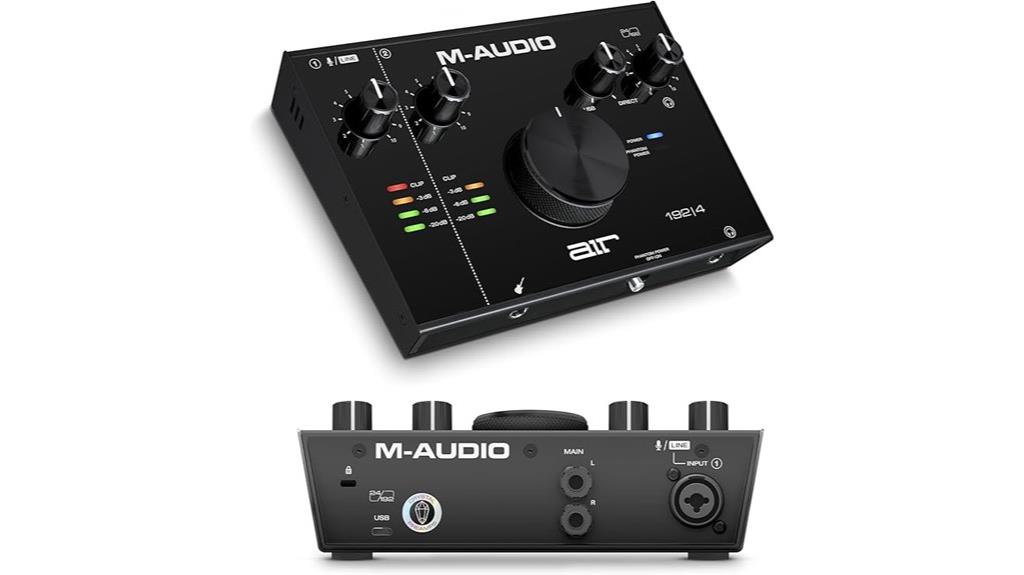
If you’re seeking a versatile audio interface that delivers studio-quality sound with seamless connectivity, the M-AUDIO AIR 192|4 USB-C stands out as an excellent choice. Its 24-bit/192kHz resolution captures every detail with crystal-clear clarity, thanks to transparent preamps and high-quality A/D converters. The USB-C and USB ports ensure fast, reliable connections, and it includes both cables for compatibility. With combo inputs, instrument and stereo outputs, plus a dedicated headphone output, it suits various recording setups. Low latency of just 2.59ms makes real-time monitoring smooth. Its rugged build, intuitive controls, and bundled software make it perfect for studio work, streaming, or podcasting.
Best For: musicians, podcasters, streamers, and home studio producers seeking professional-quality audio with reliable connectivity and low latency.
Pros:
- High-resolution 24-bit/192kHz audio for clear and detailed recordings
- Rugged metal chassis ensures durability for mobile and studio use
- Low round trip latency of 2.59ms supports real-time monitoring and performance
Cons:
- Limited I/O options may not suit complex multi-instrument setups
- May require compatible devices with USB-C or USB ports for optimal performance
- Software bundle may have a learning curve for beginners
JOYO Guitar Audio Interface with Type-C and Lightning for Phones
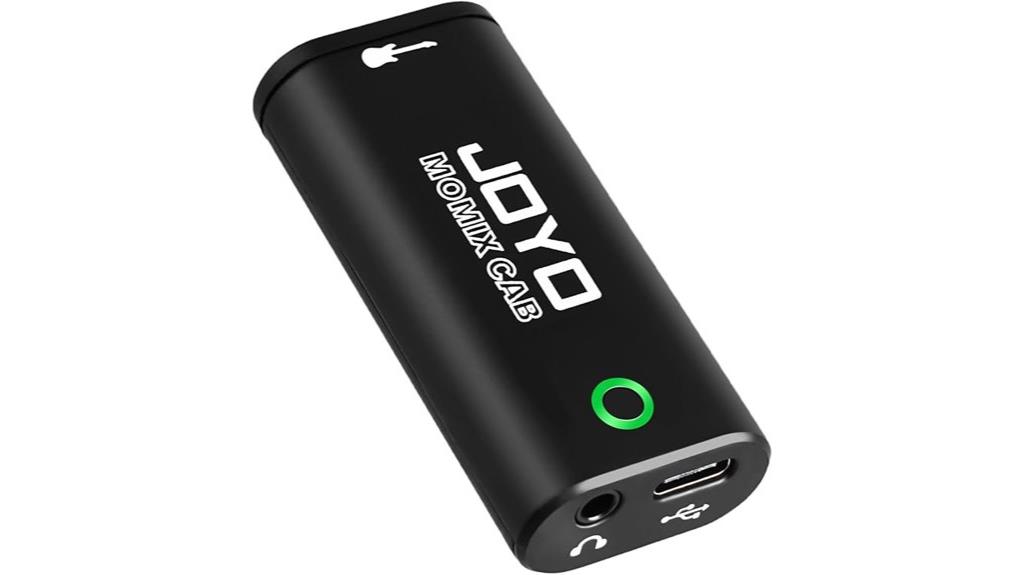
Designed for guitar enthusiasts on the go, the JOYO Guitar Audio Interface with Type-C and Lightning ports offers a portable, plug-and-play solution that captures authentic sound directly into your smartphone. It supports Android devices with OTG functionality and connects via USB-C or Lightning. The interface includes a 6.35mm jack for guitar or bass and a 3.5mm monitoring port, making it ideal for quick recordings. Its lightweight, clip-on design fits easily in your pocket, perfect for spontaneous sessions. While it’s mainly for recording and live streaming, it delivers high-quality, low-latency sound with minimal interference—no extra editing needed.
Best For: guitar enthusiasts and mobile musicians seeking a portable, easy-to-use audio interface for high-quality recording directly into smartphones.
Pros:
- Compact and lightweight design with a convenient clip for portability
- Plug-and-play setup with no need for external power or charging
- Supports real-time, low-latency recording with minimal interference
Cons:
- Limited to basic recording functions; no editing or mixing capabilities
- Monitoring interface lacks independent volume control
- Compatibility may be restricted to apps that support direct audio input from the device
2i2 USB-C Audio Interface for PC/Mac
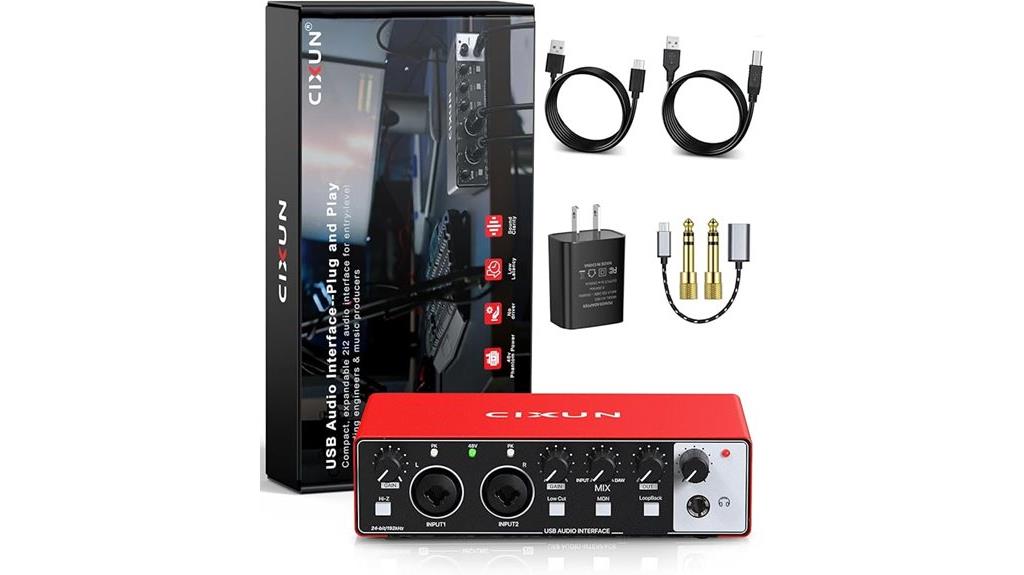
The i2 USB-C Audio Interface stands out for its effortless plug-and-play setup, making it an excellent choice for anyone who wants quick, studio-quality recording without the hassle of installing drivers or complex software. Simply connect it via USB, and you’re ready to record in 24-bit/192kHz quality. Compatible with both PC and Mac, it offers a durable matte metal shell for portability and reliability. With dual XLR/TS inputs, phantom power, and Hi-Z support, it handles vocals, instruments, and streaming effortlessly. Front controls for gain, monitoring, and loopback make adjustments intuitive, while zero-latency monitoring ensures smooth performance in any studio or portable setup.
Best For: musicians, podcasters, streamers, and content creators seeking high-quality, portable audio recording with easy setup.
Pros:
- Plug-and-play design with no driver installation required for quick setup.
- Supports professional 24-bit/192kHz recording for studio-quality sound.
- Durable matte metal shell offers portability and long-term reliability.
Cons:
- Requires external power source via USB-C power supply, limiting portability in some scenarios.
- Limited to USB 2.0 data transfer; may not utilize higher-speed USB standards.
- May lack advanced features found in higher-end audio interfaces, such as multiple monitor outputs or extensive software integration.
Factors to Consider When Choosing Professional Audio Interfaces
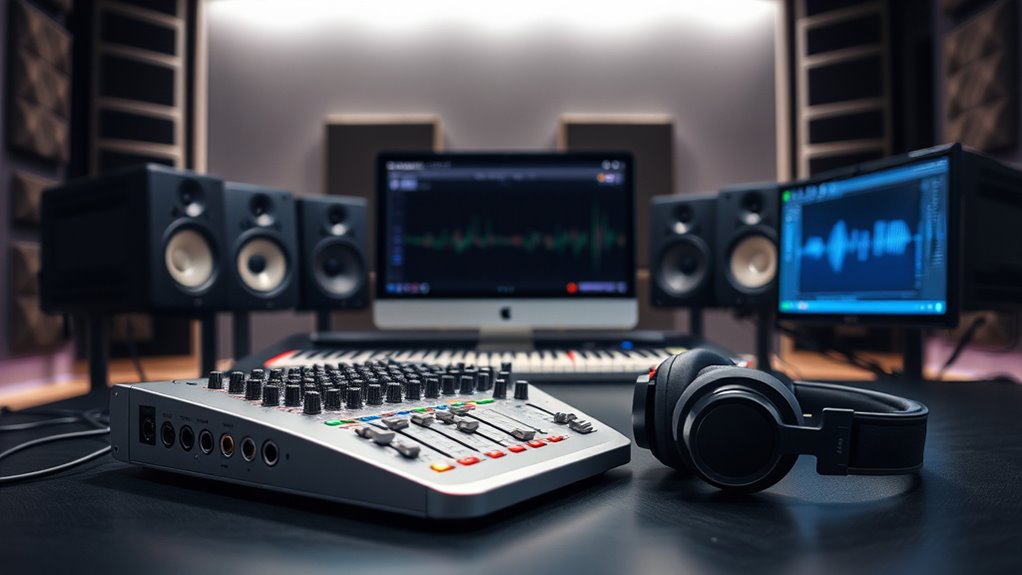
When selecting a professional audio interface, I consider key factors like audio quality standards, compatibility, and connectivity options to guarantee seamless setup. I also look at preamp and conversion quality for clear sound, along with portability and durability for on-the-go use. Additionally, software and features play a big role in maximizing the interface’s functionality and ease of use.
Audio Quality Standards
Choosing a professional audio interface hinges on understanding critical audio quality standards that guarantee your recordings are clear, accurate, and true to life. I look for interfaces supporting at least 24-bit/96kHz resolution, with higher standards reaching 24-bit/192kHz for superior fidelity. High-quality converters are essential—they ensure precise analog-to-digital and digital-to-analog transformation, minimizing signal loss. A dynamic range of 120dB or more indicates the interface can handle both quiet and loud sounds without distortion, which is crucial for professional results. Low total harmonic distortion (THD) and noise levels help maintain clarity and prevent unwanted coloration. Additionally, quality preamps with ample gain and transparency greatly influence the warmth and clarity of my recordings, making these standards fundamental when choosing an interface.
Compatibility and Connectivity
Ensuring compatibility and connectivity is essential for seamless integration of your audio interface into your setup. First, verify that the device works with your computer’s operating system—Windows, macOS, or Linux—and supports your preferred connection type, like USB, Thunderbolt, or PCIe. Check that your computer has the necessary ports such as USB-C, USB-A, or Thunderbolt to connect without extra adapters. It’s also important to confirm the interface supports high-quality audio standards, like 24-bit/192kHz sample rates. Additionally, consider the number and types of inputs and outputs—XLR, TRS, or instrument jacks—that match your recording needs. Ultimately, confirm the interface is compatible with your DAW software and any other hardware or peripherals you plan to use for a smooth workflow.
Preamp and Conversion Quality
High-quality preamps and conversion components are essential for capturing and reproducing sound with clarity and accuracy. I look for preamps that deliver clean, transparent gain with minimal noise and distortion, ensuring my recordings sound natural. Superior analog-to-digital converters are vital for preserving sonic detail during both recording and playback, which is crucial for professional results. The dynamic range of these components determines how well they handle quiet and loud sounds without clipping or noise issues. Features like phantom power and variable impedance settings help optimize microphone and instrument compatibility, boosting fidelity. Low total harmonic distortion (THD) and high headroom in preamps and converters ensure my audio remains clear and natural, with minimal coloration, even at high levels.
Portability and Durability
When selecting a professional audio interface for mobile or studio use, portability and durability are key considerations that can’t be overlooked. A portable device should be compact and lightweight—ideally under 2 pounds—to make transport effortless. Durability features like a metal chassis and reinforced corners protect against physical damage during travel. Reliable connectivity options such as USB-C, Thunderbolt, or dedicated power supplies ensure stable operation across different environments. Devices with rugged construction and minimal moving parts are less prone to wear and failure over time. Additionally, a durable interface must withstand environmental factors like temperature changes, minor shocks, and vibrations typical of mobile setups. Prioritizing these features helps guarantee your audio interface remains reliable and resilient, no matter where or how you record.
Software and Features
Choosing the right audio interface involves more than just durability; the software and features it offers can considerably boost your workflow. Many professional interfaces come bundled with powerful software like DAWs, plugins, and effects, which streamline recording and mixing. Features such as zero-latency monitoring, loopback functions, and control surface integration improve real-time audio management and efficiency. High-resolution support, typically 24-bit/192kHz, guarantees detailed, studio-quality sound for both recording and playback. Compatibility with industry-standard DAWs like Pro Tools, Ableton Live, and Logic Pro ensures seamless integration into your existing setup. Additionally, onboard tools like EQ, compression, and virtual instruments expand creative possibilities directly within the interface ecosystem, making software and features a crucial consideration for any serious audio professional.
Frequently Asked Questions
How Do Audio Interface Latency Levels Affect Recording Quality?
Latency levels directly impact my recording quality because high latency causes noticeable delays between when I play or sing and when I hear the playback. This lag can throw off my timing and make recording sessions frustrating. I prefer low-latency interfaces because they offer real-time monitoring without delay, helping me stay in sync and produce professional-sounding tracks. Reducing latency is essential for a smooth, accurate recording experience.
Can I Connect Multiple Instruments Simultaneously Without Additional Hardware?
Yes, you can connect multiple instruments simultaneously without extra hardware if your audio interface has enough inputs. I always verify the number of available input channels before recording multiple instruments at once. Many professional interfaces offer multiple mic and instrument inputs, making it easy to record a full band or several instruments without additional gear. Just make certain your interface supports the number of instruments you plan to connect for smooth recording sessions.
What Are the Differences Between USB-C and Traditional USB Connections?
Think of USB-C as the sleek, modern highway, while traditional USB is the familiar back alley. USB-C offers faster data transfer, higher power delivery, and a more versatile connection. It’s reversible, so no more fumbling to plug it in. Traditional USB ports are still common but slower and less efficient. Upgrading to USB-C means smoother, quicker, and more reliable connections for your audio gear.
How Important Is Preamp Quality in Professional Audio Interfaces?
Preamp quality is essential in professional audio interfaces because it directly affects the clarity, warmth, and accuracy of your sound. Good preamps minimize noise and distortion, ensuring your recordings are pristine. I always prioritize interfaces with high-quality preamps to capture detailed, professional-grade audio. Skimping on preamp quality can compromise your overall sound, making it harder to achieve that studio-quality result you’re aiming for.
Are There Compatibility Issues With Specific DAWS or Operating Systems?
Think of compatibility like a dance partner—if they don’t match your rhythm, it’s awkward. I’ve found that most top audio interfaces are highly compatible with popular DAWs and operating systems, but occasional hiccups happen, especially with newer software updates or niche programs. To avoid surprises, I recommend checking the manufacturer’s compatibility list before buying. This way, you’ll stay in sync and keep your creative flow uninterrupted.
Conclusion
So, after all this talk about pristine sound, it’s funny how we chase perfection when a good interface is really just about making noise sound “right.” Whether you pick a Focusrite or M-Audio, remember: the magic isn’t in the gear alone, but in how you use it. Ironically, sometimes the simplest setup can turn your messy ideas into studio-quality magic—if you want to call it that.









